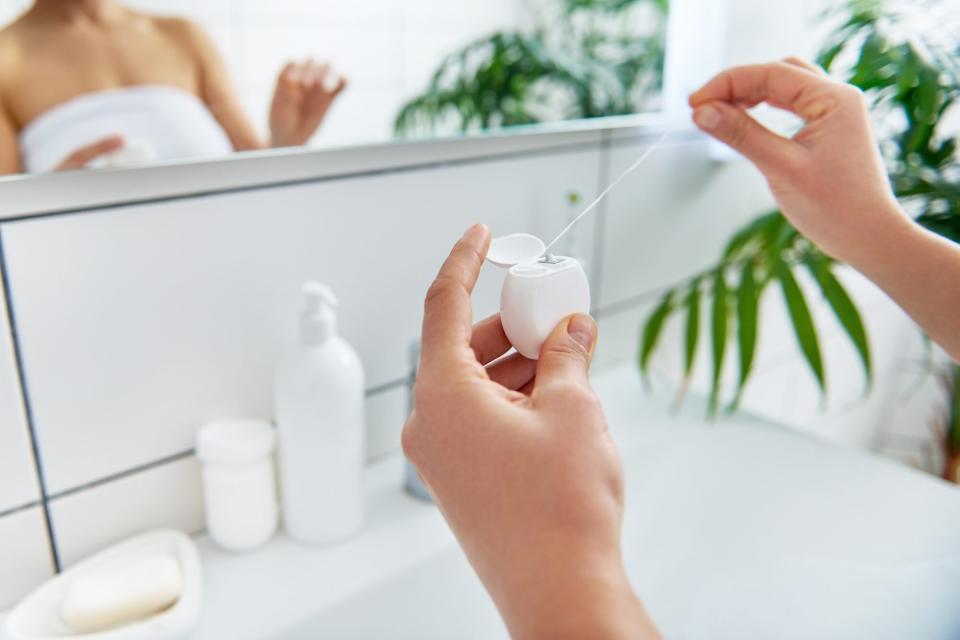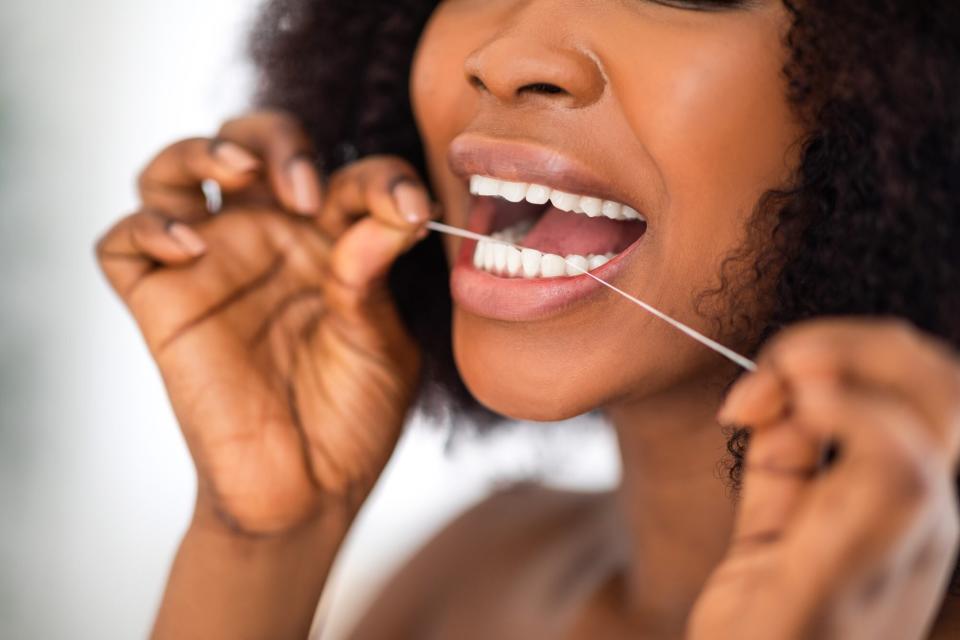How to Properly Floss Your Teeth, According to Dentists
TABLE OF CONTENTS
On This Page
Flossing 101
Flossing Frequency
Flossing Tools
How to Floss
From twice-a-day brushing to using mouthwash, we do a lot to keep our teeth squeaky clean and sparkling. Another dental habit you don't want to skimp on is flossing—it's so important to our long-term dental health. If you are not quite sure why it's necessary (or even how to do it, exactly), we have you covered. This is how dentists say you should floss—plus, they share a few floss alternatives you can use to best suit your dental needs.
Related: The 7 Best Toothbrushes, All Approved by Dental Experts
Why It's Important to Floss Your Teeth
Flossing may add another step to your dental routine, but it's a critical one that removes food and bacteria from your teeth and gums, says Nadia Rodriguez, DMD, a dentist at No Limits Dental. "Food and the bacteria that feast on it cause inflammation of the gums, which is known as gingivitis," she says. "While gingivitis is reversible, it can lead to periodontitis, which is when there is bone loss, leading to loose teeth."
Flossing every day also helps prevent tooth decay, bad breath, staining, and the yellowing of our teeth, says Marc Lowenberg, DMD, a cosmetic dentist of Lowenberg, Lituchy & Kantor. The process removes plaque and tartar that could remain on the teeth for prolonged periods of time.

Taras Grebinets / GETTY IMAGES
How Often to Floss Your Teeth
Make sure to floss at least every night; your body produces less saliva at this time of day and, in turn, transforms your mouth into a breeding ground for bacteria. "If you remove the bacteria every night, there will be less that multiply and cause gum disease," says Dr. Rodriguez. "During the day, you produce more saliva, which helps wash away food and bacteria in your mouth."
When to Floss
Floss in the middle of your dental routine—after you brush your teeth, but before you use mouthwash. "Brushing and flossing loosens plaque and mouthwash helps to rinse it away," says Dr. Lowenberg. "In order for mouthwash to be most effective, you should floss your teeth first, because a lot of odors come from foods stuck between teeth." His advice is to swish mouthwash between your teeth for 10 seconds after flossing.

GETTY IMAGES
Flossing Tools
There are several tools on the market that you can use for flossing. Consider these expert-approved options to care for your teeth.
Standard Flosses
There are two types of standard flosses: nylon (or multifilament) floss and PTFE (monofilament) floss. The biggest difference between the two is that nylon is made of multiple threads of nylon (waxed or unwaxed) and PTFE consists of a single thread of durable Teflon. As a general rule of thumb, use a waxed version of floss, since it easily glides through teeth, says Dr. Lowenberg. Consult your dentist if you think you need a more durable or unwaxed option.
Water Flossers
If you have stubborn food and plaque between your teeth, and you struggle with traditional floss, using a water flosser is a good alternative to traditional floss. "Flossing the right way requires a lot of effort and is especially difficult for people with small mouths to do properly," says Dr. Lowenberg. "Water flossing is easy because all you have to do is hold the device and it does the water blasting for you."
Water floss once a day—however, if you have spaces between your teeth that easily catch food, use this tool, like the Waterpik Aquarius, after every meal, Dr. Lowenberg suggests. Be mindful of the water pressure. If you notice damage to your gums, decrease to a lower water pressure level.
Floss Threaders
There are certain instances where floss threaders, which are like a needle and thread, come in handy. "People who have fixed bridges, which are permanently cemented and replacing one or more missing teeth, do need to floss under the bridge," says Dr. Lowenberg. "Also, people who have bonded permanent retainers to keep their teeth from moving need to floss under the permanent retainer." He explains that it's impossible to floss normally since the teeth are attached to each other in both of these dental restorations.
To use this tool, thread the floss through the eye of the holder and then move the threader between the tooth, pulling the floss through, says Dr. Lowenberg. If you have difficulty, consult your dentist on how to use the floss threader.
Floss Holders
People who find flossing difficult, or lack the dexterity to floss properly, will find it useful to buy and use a floss holder, says Dr. Lowenberg. This is a small tool that has floss on the handle, like these.
How to Floss Your Teeth
The best way to floss is by using a traditional piece of string floss. "If you have gum disease, or if your gums bleed when you floss, see your dentist," says Dr. Rodriguez. "Your gums should not bleed if you floss every day."
Follow the dentists' best practices to floss your teeth:
Wrap the floss around one finger (Dr. Rodriguez likes wrapping it around her middle finger) on each hand and then hold it by applying tension to the floss.
Push the floss past the contacts of your teeth (you should feel a snap) and then rub the floss up and down against the side surface of the tooth in the front and back. This movement should be like a "C" shape, rather than quickly snapping the floss between each tooth, says Dr. Lowenberg.
Rub the floss underneath the gums to clean away any bacteria that may be breeding under the gums.

